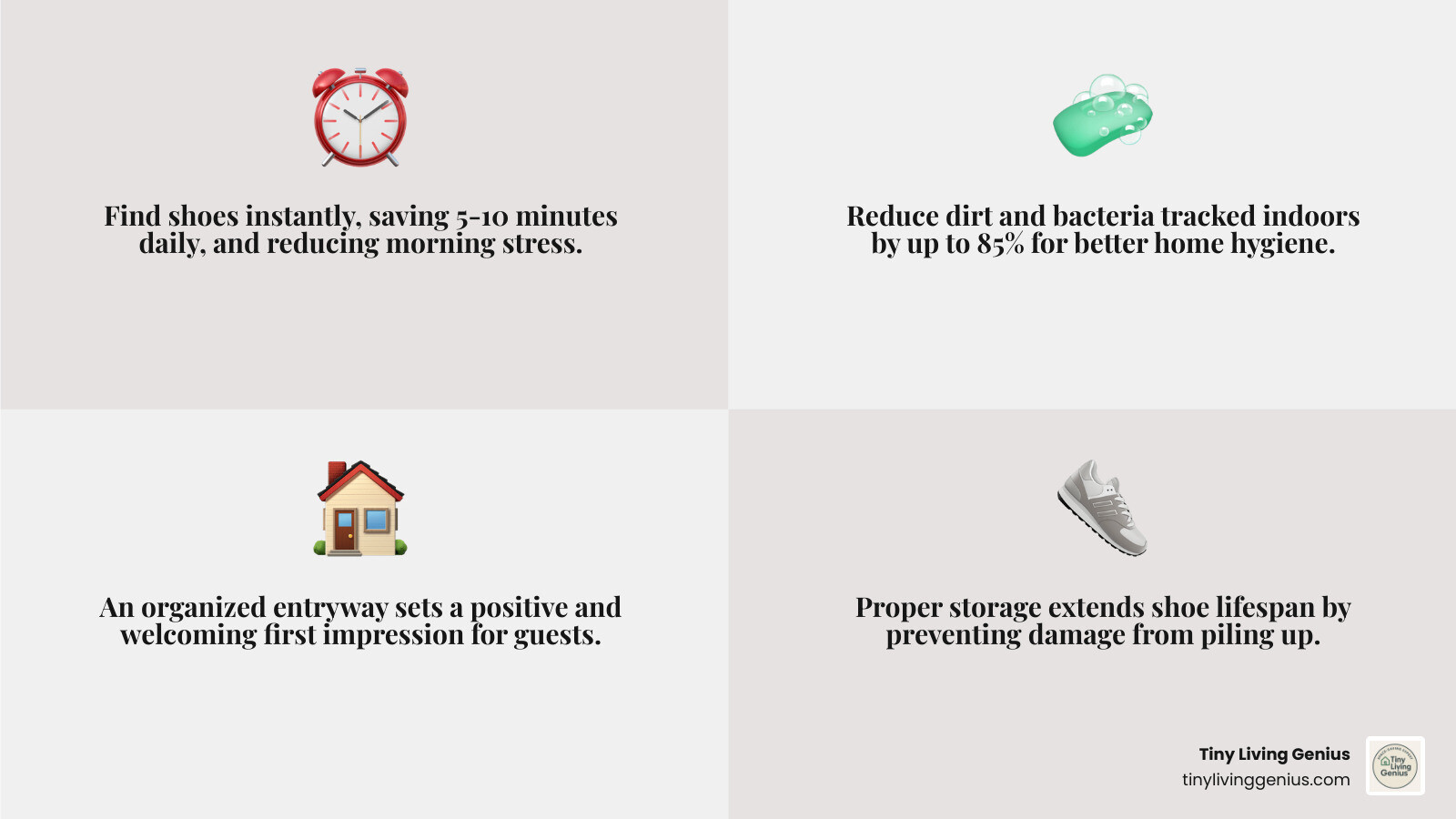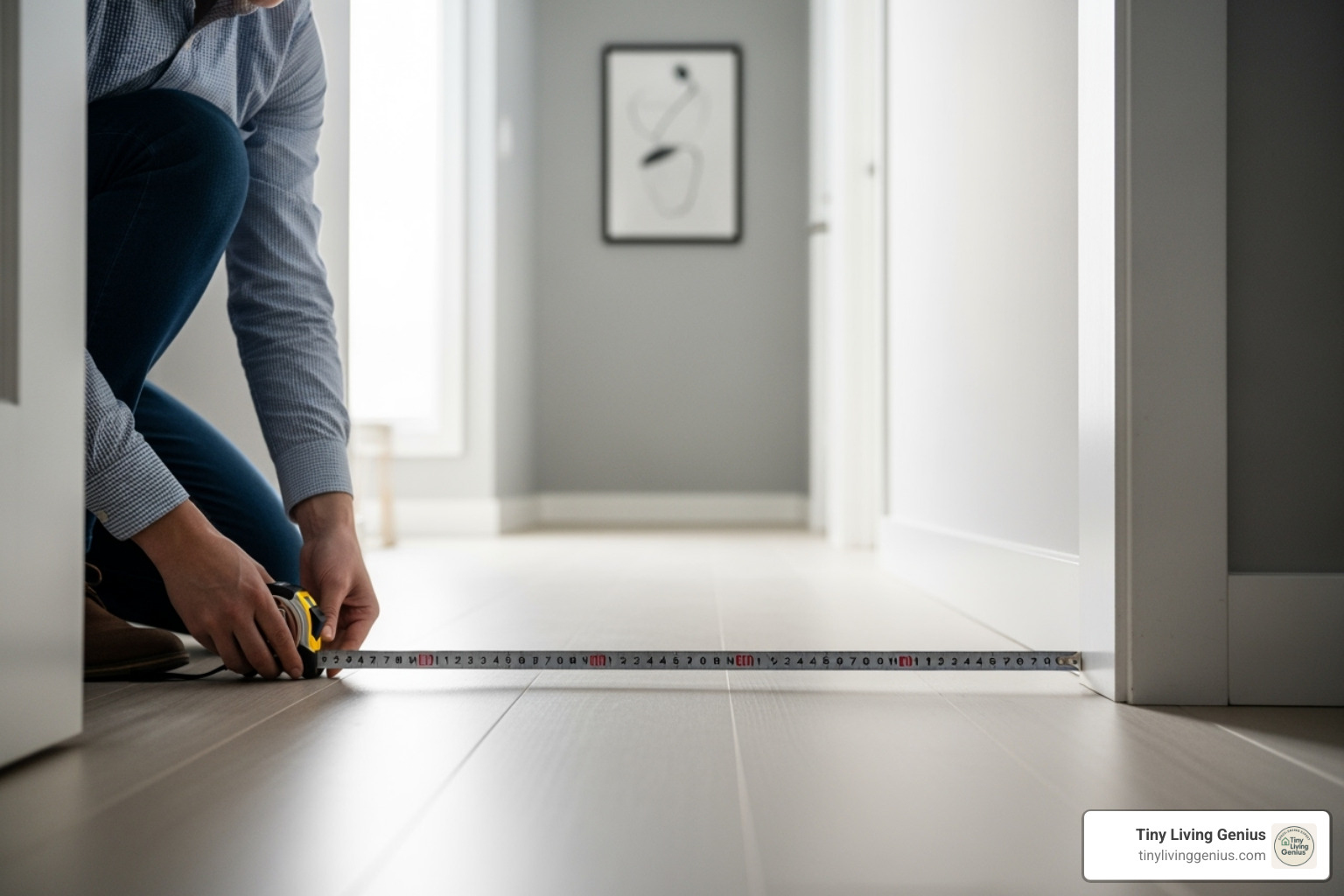Shoe storage entryway: Genius Solutions 2025
Why Entryway Shoe Storage Is Essential for Small Spaces
Shoe storage entryway solutions transform a cluttered front door into an organized, welcoming space, saving you time and stress daily.
Quick Answer: Best Entryway Shoe Storage Solutions
- Slim cabinets (11-12″ deep) – Perfect for narrow hallways, hide shoes behind doors
- Storage benches with cubbies – Dual-purpose seating and storage for 9+ pairs
- Tiered vertical racks – Maximize wall space, hold 16-20 pairs in minimal floor space
- Over-the-door organizers – Zero floor space, 15-minute setup, $15-50
- Decorative baskets – Simple, flexible storage for frequently worn shoes
As one homeowner put it, “My front door opens directly into my very open living room… and there are a LOT of shoes by the door.” For many in small spaces, this reality means visual clutter and a stressful first impression.
The numbers tell the story. The average American household has 19 pairs of shoes per person. For a family of four, that’s 76 pairs competing for space in what’s often the smallest area of your home. When you’re battling limited square footage, an entryway shoe pile isn’t just unsightly—it’s a daily obstacle that eats into your living space.
The good news? The right storage strategy reclaims your entryway, protects floors from dirt, and replaces chaos with calm. There’s a solution for every space, budget, and lifestyle.
I’m Ramy Saber, a Civil Engineer and founder of Tiny Living Genius, where I specialize in solving space challenges for compact living environments. Through years of researching and testing shoe storage entryway solutions, I’ve helped countless readers transform their cramped entryways into functional, organized spaces. Let me show you how to do the same.

The “Why”: Key Benefits of an Organized Entryway
That jumbled pile of shoes by the door does more damage than you think. A smart shoe storage entryway system doesn’t just organize shoes—it changes how your home feels and functions.
The ripple effect starts with decluttering. When shoes are scattered, the chaos bleeds into your entire living space. As one homeowner said, their messy entry was “awful and had zero function.” Corral those shoes, and your home instantly feels more spacious and intentional—a peaceful retreat.
First impressions matter—even to ourselves. Your entryway sets the tone every time you walk through the door. Is it calm or chaotic? An organized entryway creates a welcoming first impression for guests, but more importantly, for you. Coming home to a tidy space helps you feel proud and relaxed.
Those frantic morning shoe hunts? Gone. We’ve all been there—running late, digging through a pile of footwear for a matching shoe. With a proper shoe storage entryway setup, every pair has its spot. You know exactly where your sneakers are, and the kids’ shoes aren’t hiding under the couch. Those saved minutes turn stressful mornings into smooth routines.
Your shoes will actually thank you. When footwear is tossed in a heap, shoes get scuffed, crushed, and bent out of shape. Proper storage keeps each pair in good condition, extending their life and saving you money on replacements.
Then there’s the health factor. More people are embracing the shoes-off-at-the-door habit for good reason. The amount of dirt and bacteria we track inside on our shoes is shocking. A designated spot for footwear at your entrance supports this healthier habit and keeps your living areas cleaner.
At Tiny Living Genius, we believe smart storage is about creating a home that works for you, especially when space is tight. For more ways to maximize your compact living area, explore our complete guide on Smart Storage Solutions for Small Spaces.
Types of Entryway Shoe Storage: From Racks to Benches
Choosing the right shoe storage entryway solution means finding the perfect fit for your space, lifestyle, and aesthetic. Luckily, options range from simple racks to clever multi-functional furniture that works overtime in small spaces.

First, decide between open and closed storage. Open solutions (racks, baskets) offer instant access and let you display shoes. Closed storage (cabinets, benches with doors) hides clutter, creating a calm look that’s valuable in small spaces.
At Tiny Living Genius, we love multifunctional furniture—pieces that do more than one job. A bench that stores shoes and provides seating is the kind of smart thinking that makes small spaces work. For more inspiration, check out our guide on Creative Furniture Solutions for Small Spaces.
Shoe Racks & Shelves
Shoe racks and shelves are the reliable workhorses of entryway storage: straightforward, affordable, and available in many configurations.
Tiered racks are clever, stacking shoes vertically to fit 16-20 pairs in a compact footprint. Stackable units offer even more flexibility, letting you add tiers as your collection grows.
The real magic is thinking vertically. Wall-mounted racks or tall, slim shelves lift shoes off the floor, which is crucial in narrow entryways. Using otherwise empty wall space makes your entryway feel more open.
When it comes to materials, metal racks are MVPs for wet or muddy shoes, as they handle moisture without warping and are easy to clean. Wood and bamboo offer warmth, while plastic can be budget-friendly.
Want to dive deeper into making the most of your walls? Our resource on Maximize Vertical Space in Small Spaces has plenty of ideas.
Shoe Storage Benches
Storage benches are fantastic for families, combining a place to sit with hidden storage. This dual-purpose design is perfect for limited square footage.
A place to sit while putting on shoes is a game-changer. No more hopping on one foot to tie laces, and kids can manage their own shoes easily. As one design enthusiast noted, entryway seating is one of the smartest decor decisions you can make.
Cubby benches feature open compartments, perfect for sorting shoes by family member. The open design makes it easy for little ones to put their shoes away.
If you prefer everything tucked out of sight, flip-top benches are your answer. The hinged seat lifts to reveal hidden storage. A large flip-top bench can fit nine pairs lined up neatly, and some designs include a small drawer—ideal for compact entryways.
Browse more clever furniture ideas in our Furniture Ideas for Small Spaces section.
Cabinets: The Ultimate Shoe Storage Entryway Organizer
For a polished, clutter-free look, shoe cabinets are your best friend, blending seamlessly into your home’s decor.
The beauty of cabinets is their concealed storage. Shoes disappear behind doors, making your entryway look sophisticated and tidy. This is especially valuable in open-concept homes.
For narrow hallways, slim tilt-out cabinets are lifesavers. These designs are as shallow as 6 to 7 inches deep, storing shoes vertically in tilting compartments to maximize capacity without eating up floor space.
Traditional cabinets with doors work well with more room, looking like an attractive piece of furniture while providing substantial storage.
There’s also the dust-free advantage. Enclosed storage protects shoes from dust and pet hair, which is great for pairs you don’t wear daily.
Creative & Unconventional Solutions
Storage ottomans are wonderful tucked under a console table for hidden storage and extra seating.
Decorative baskets and bins offer the quickest solution for everyday shoes. Large woven baskets look stylish while keeping footwear contained. You could assign each family member their own basket.
A rolling cart, like a 2-tier basket under 12 inches wide, holds a surprising number of pairs and can be rolled into a corner when you need space.
Don’t overlook repurposed furniture. Homeowners have turned bar cabinets, small dressers, and even wine cubbies into creative shoe storage for a unique, budget-friendly look.
Here are some unconventional items that work surprisingly well for shoe storage:
- Wooden crates stacked or wall-mounted create rustic, customizable cubbies
- Floating shelves display shoes while keeping them off the floor
- Upcycled Tiny Living Genius products like compact shelving units or small folding tables adapted for shoe storage
The key is looking at your space with fresh eyes and asking, “What could this become?”
Choosing Your Ideal Shoe Storage Entryway Solution

Finding the right shoe storage entryway solution isn’t about buying the first thing that looks nice online. It’s about understanding your space, your family’s habits, and what will actually work day after day. I’ve seen too many beautiful storage pieces end up as expensive decorations because they didn’t match how people actually live.
Let’s start with what really matters: your specific needs. Before you measure anything or browse any websites, think about your daily routine. Do you rush out the door every morning? Do your kids kick off muddy cleats after soccer practice? Does your partner collect sneakers? These questions aren’t just small talk—they’re the foundation of choosing storage that you’ll actually use.
Functionality should always come first. A gorgeous cabinet that’s too deep for your hallway or too complicated for your kids to use isn’t doing you any favors. At Tiny Living Genius, we believe your furniture should work for you, not create new problems. That’s why our guide on How to Choose the Right Furniture for Your Small Space: A Comprehensive Guide emphasizes practical decision-making over trendy purchases.
Factor 1: Space & Dimensions
Here’s where many people stumble right out of the gate. They fall in love with a storage solution online, order it, and then find it completely blocks their hallway. Trust me, I’ve heard this story more times than I can count.
Grab your tape measure first. Seriously, before you do anything else, measure your entryway width, depth, and height. Note where doors swing open, where people naturally walk, and where existing furniture sits. That narrow landing or entryway that opens directly into your living room? It needs special attention.
For tight spaces, slimline designs aren’t just nice—they’re essential. Cabinets that are only 11-12 inches deep can tuck against a wall without turning your hallway into an obstacle course. I’ve seen people try to squeeze in 18-inch deep cabinets in narrow spaces, and it never ends well. You’ll constantly be turning sideways to get past it.
When floor space is limited, think vertically. Wall-mounted racks or tall, slim shelving units let you maximize storage capacity without eating up your precious square footage. This is one of the most underused strategies in small entryways.
Now, here’s a helpful guideline: most shoes need at least 13 inches of depth to sit comfortably on a shelf, especially boots and heels. However, clever slim cabinets use angled compartments to store shoes at a tilt, reducing their overall depth while still fitting most footwear types. For more detailed measurements, you can check out Shoe Rack Dimensions: The Ultimate Guide for comprehensive specifications. We’ve also written extensively about maximizing vertical space in our article Maximize Vertical Space in Small Spaces.
Here’s a quick comparison to help you visualize what different storage types offer:
| Type of Storage | Typical Depth | Typical Width | Typical Height | Estimated Capacity (pairs) | Notes |
|---|---|---|---|---|---|
| Slim Shoe Cabinet | 6-12 inches | 20-40 inches | 30-50 inches | 6-18 | Tilt-out design, good for narrow halls |
| Shoe Storage Bench | 13-18 inches | 30-50 inches | 18-20 inches | 6-12 (cubbies) | Seating + storage, often with cubbies |
| Multi-tiered Rack | 12-14 inches | 24-36 inches | 20-40 inches | 9-20 | Open storage, stackable, vertical |
| Over-the-Door Organizer | 4-6 inches | 18-24 inches | 48-60 inches | 12-24 | Zero floor space, ideal for small spaces |
Factor 2: Shoe Volume & Type
Your shoe collection tells a story about your life, and your shoe storage entryway should honor that reality. Yes, the average American household has about 19 pairs of shoes per person, but here’s the thing: not all of those shoes need to live by your front door.
Think about which shoes you actually wear regularly. Those are your entryway shoes. Winter boots can go in the coat closet. Dress shoes and specialty footwear belong in bedroom closets. This “doorside shoe count” strategy can dramatically reduce the storage you need right by the door, opening up more options that fit your space.
If you need to store tall boots, look for solutions with adjustable shelves or specific boot compartments. These need vertical clearance and that minimum 13-inch depth to avoid crushing them. Similarly, high heels need adequate height and a stable surface to keep them from toppling over like dominoes. Angled shelves or individual cubbies work beautifully for both.
Got kids? Their shoes are smaller but somehow multiply overnight. Open cubbies or individual baskets make it easy for children to put their own shoes away. Many parents find success keeping adult shoes on higher shelves and placing kids’ shoes on the bottom level—this teaches independence while keeping little shoes from getting lost in the shuffle.
Factor 3: Aesthetics & Style
Let’s be honest: your shoe storage entryway is one of the first things people see when they enter your home. It needs to look good, not like you dragged in furniture from a storage unit.
Consider your existing decor style. Is your home modern and minimalist? Farmhouse cozy? Traditional and neat? There’s a storage solution for every aesthetic. I’ve seen people buy perfectly functional shoe storage that looked completely out of place, and it bothered them every single day. The visual disconnect matters.
Material and color choices make a huge difference. Sleek metal and white wood offer a contemporary vibe. Warm oak veneer and rustic bamboo bring natural warmth. Black finishes add modern drama. White, black, and natural wood tones remain popular because they work with almost any decor scheme.
Don’t forget about the top surface of cabinets and benches—it’s prime real estate for personality. A table lamp adds warm lighting. Plants bring life and freshness. A mirror makes the space feel larger. These welcoming details help your storage piece feel like intentional furniture, not just a utilitarian box.
At Tiny Living Genius, we’re passionate about Efficient Design for Small Spaces: Stylish Living Solutions for Small Spaces that never compromise on style for the sake of function. You can have both.
Factor 4: Accessibility & Family Needs
Here’s where theory meets reality. The most brilliant storage solution in the world is worthless if nobody in your household actually uses it.
Kid-friendly designs prioritize simplicity. Open cubbies or low benches beat complicated drawer systems every time. One parent shared a painful truth with me: asking a child to pick up shoes, open a drawer, put shoes in, then close the drawer is simply too many steps—for both kids with ADHD and busy adults. The shoes end up on the floor because the system fights against human nature.
Easy-access open cubbies are champions for families. Everyone can see where their shoes go. Kids can reach them independently. There’s no fumbling with doors or drawers when you’re running late. Each family member gets a designated cubby, and cleanup becomes almost effortless.
Safety matters, especially with taller storage units. If you have small children, look for anti-tip kits or anchor furniture securely to the wall. Climbing accidents are preventable with simple precautions.
The golden rule? Simpler is better. Benches with open cubbies, straightforward racks, or individual baskets consistently outperform complex storage systems because people actually use them. And when you integrate seating into your shoe storage, you make the entire process more comfortable—sitting down to tie laces or remove boots prevents that awkward one-legged dance we’ve all done.
The best shoe storage entryway solution is the one that matches how your household actually functions, not how you wish it functioned. Choose accordingly.
Frequently Asked Questions about Entryway Shoe Storage
Let’s tackle some of the most common questions we get from readers about organizing shoes in tight entryways.
How can I organize shoes in a very small entryway with no closet?
For a tiny entryway with no closet, the secret is thinking vertically and staying slim. The right solution can transform these challenging spaces.
Wall-mounted racks are brilliant because they take up zero floor space, keeping shoes accessible while leaving the floor clear. For an even simpler approach, over-the-door organizers are game-changers. They cost between $15-$50, take minutes to hang, and use the wasted space on the back of your door.
If you prefer a cleaner look, slim shoe cabinets from Tiny Living Genius are designed for narrow spaces. Look for ones that are 6-10 inches deep with tilt-out compartments. This clever design hides clutter while barely protruding into your walkway.
Another option we love is tucking a single storage ottoman from our collection under a console table. It provides seating and hidden storage in a compact footprint.
The key is keeping floor space as open as possible to make the entryway feel more spacious.
What’s the best way to store wet or muddy shoes?
Wet, muddy shoes are an entryway’s worst nightmare, but a little planning can prevent them from wreaking havoc.
The simplest solution is placing a waterproof tray or mat inside or under your Tiny Living Genius storage unit. This catches drips and mud before they reach your floors or damage furniture, saving you cleaning headaches.
For shoes that are regularly wet, choose storage made from durable, easy-to-clean materials like metal or plastic. Metal shoe racks are excellent for wet shoes because they won’t absorb moisture and can be wiped clean. Avoid untreated wood for your wet shoe zone.
Also, ensure wet shoes have good airflow to dry properly. If using a cabinet, leave the doors ajar, or use an open rack as a designated “wet shoe” area.
Are there any good DIY shoe storage entryway ideas?
Yes, and DIY solutions can be creative and budget-friendly! We love seeing what our community comes up with.
Building simple shelves with wood crates is a classic DIY project. You can stack them, mount them to the wall, and paint them to match your decor. One resourceful reader built custom corner shelves using bargain wood for around $30, proving you don’t need a huge budget.
For something unexpected, repurpose a ladder for hanging heeled shoes. It creates a practical and visually interesting vertical display. Wine cubbies from old bar cabinets can also be perfect for smaller shoes.
We also encourage thinking about upcycled Tiny Living Genius products in new ways. A compact shelving unit for books could easily house shoes. Our modular furniture is designed to be versatile, so get creative.
For a softer approach, try fabric bins on open shelves, with one for each family member. It’s simple, customizable, and makes cleanup a breeze for kids.
Conclusion
So here we are, at the end of our shoe storage entryway journey together. We’ve explored why that pile of shoes by your door matters more than you might think, finded countless creative solutions, and tackled the tricky questions that come up when trying to organize in tight quarters.
The truth is, an organized entryway does something almost magical. It doesn’t just hide your shoes—it transforms how you start and end each day. No more frantic searching while you’re already late. No more tripping over boots in the dark. No more feeling embarrassed when someone knocks on your door. Instead, you get a calm, welcoming space that actually makes you smile when you walk in.
Whether you’ve fallen in love with a sleek slim cabinet that disappears into your narrow hallway, a cozy storage bench where your kids can finally sit down to tie their shoes, a vertical rack that uses your wall space brilliantly, or even a creative DIY solution using wooden crates or repurposed furniture, what matters most is that it works for your life. Your specific space, your unique shoe collection, your family’s habits, and yes, even your personal style—they all deserve to be part of the equation.
At Tiny Living Genius, we’ve seen how smart storage transforms small spaces into homes that feel twice their size. We believe every square inch of your compact home has potential, including that often-overlooked spot right inside your front door. You deserve an entryway that serves you well, not one that creates daily stress.
So take a deep breath, measure your space, and pick a solution that speaks to you. Your future self—the one who walks in tomorrow with an armful of groceries and doesn’t have to steer a shoe obstacle course—will thank you.
Ready to tackle more small-space challenges? We’ve got your back. Explore more tiny apartment tips and find how to make every corner of your compact home work beautifully for you.



